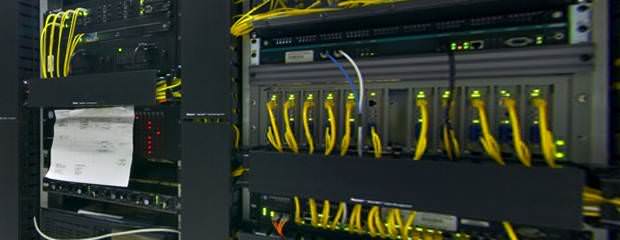
How the enabling innovation of 21st century capitalism
Often overlook is how the enabling innovation of 21st century capitalism, the digital signal, makes possible the Internet and everything we electronically take for granted, is a terrain of struggle over enclosure. The shift from analog to digital has made the imposition of private-property controls much easier. The digital signal — whether an email message, commercial transaction, phone call, musical selection, pornographic image or Hollywood blockbuster — is just a series of 1s and 0s. In this way, it is easier to monitor, commodify, price and regulate.
Yet, the digital signal's very simplicity of structure and universality of adoption has made it so easy to innovative upon, however also easy to share, to copy and to hack. Because of its simplicity, digital-based technologies as well subvert the push to impose market and government control. This fosters a digital common or Internet underground of hackers and Anonymous as then as mafia scam artists prowling for a sucker. This is the postmodern digital dialectic.
The book, record and home-movie businesses represent one terrain on which the digital dialectic, and along these lines post-modern enclosure, is playing out. The 1st round of digital research was defined by the digital product, whether CD or DVD. While this phase, the corporate media industry both benefited and lost. CD and DVD, cheaper to produce and ship, became the commercial standard, replacing records and VHS videotapes. Nevertheless CDs and DVDs, like audiotapes, records and home videos, were easy to pirate and after all are.
The midst of the second round of digital technology
We are in the midst of the second round of digital technology, the shift from the hardcopy product to an Internet-distributed file. To date, this shift has been spotty, forcing the media industry to repeatedly fine-tune its game plan. File-sharing sites like Napster led to the nearly-collapse of the century-old record business. However the industry learned and revised its business model.
Post-modern, 21st century enclosure can be seen in changes restructuring the nation's communications system. This is the near universal digital network that facilitates the distribution of the nation's - and the world's - telecommunications. Assuming no glitches, one can make a call or get online and reach someone, anyone anywhere, everywhere in the world in a matter of moments. Americans, 75-years ago, couldn't have imagined such a world.
The 1934 Communications Act
Today's telecommunications regulation is rooted in the 1934 Communications Act. This Act extended Constitutional authority to communication by recognizing telephone companies as "common carriers." In accordance with the Constitution's Article I, Section 8, Clause 3, the commerce clause, a common carrier must provide service to the public without discrimination for “public convenience and necessity.”
The common-carrier provision was at first applied to railroads, bus lines, trucking companies and other public conveyances. The Act was fashioned in an era earlier digital data and the Internet, in this way telephone common-carrier regulation originally applied only to voice messages.
Seventy-five years previously, in 1860, the Pacific Telegraph Act was enacted. It was the nation's first legislative effort to establish a neutral communications infrastructure. It stated:
The Act became law while the earliest days of the 1st great media research revolution, the analog age. This era spanned the century from the first telegraph to the now ebbing era of books, records and over-the-air broadcasting. Can you image someone while the Civil War imaging a world of 1930s telephones, let alone 21st century smartphones and tablets.
The 2nd great media innovation revolution
The 2nd great media innovation revolution, the digital age, begins with the ENIAC vacuum-tube computer in 1946 and looks like it will go on for the foreseeable future. A couple of decades later, the Internet emerges from DARPA. The military-industrial state drives technology.
Surprising to many, common-carrier regulation did not extend when communications shifted from analog to digital, from voice to data, text and other media. Clinton's 1996 Telecommunications Act marks when common carriage was privatized. The most glaring example of this process is how the nation's telecom infrastructure, the Public Switched Telephone Network, was remade from a classic utility, like water or roadways, to a private, for-profit enterprise.
Media entertainment and Internet services are two terrains on which post-modern enclosure pushes to privatize and commodify all human relations, including those mediated by innovation.
The post-modern enclosure movement has extended to wireless and the Internet. In 2007, the FCC reclassified wireless broadband as an “information service,” in this way largely freeing it from common-carrier regulation. In 2010, a federal court ruled that FCC common-carrier regulations do not apply to Internet Service Providers, the connections that link a person's computer to the "POP" on the web.
In the U.S., this utopian impulse is taking new, clever forms. It was expressed previously this year in the popular protests promoted by Change.org against corporate greed. One involved a campaign against Bank of America's effort to impose a $5-per-month fee for debit-card use; it backed down. Another involved an online petition signed by 100,000 people against Verizon Wireless announced plan to charge a $2 "convenience fee" for payments subscribers make over the phone or online with their credit or debit cards; it held off.
- · Rackspace debuts OpenStack cloud servers
- · America's broadband adoption challenges
- · EPAM Systems Leverages the Cloud to Enhance Its Global Delivery Model With Nimbula Director
- · Telcom & Data intros emergency VOIP phones
- · Lorton Data Announces Partnership with Krengeltech Through A-Qua⢠Integration into DocuMailer
